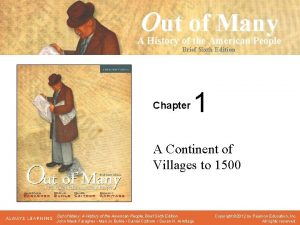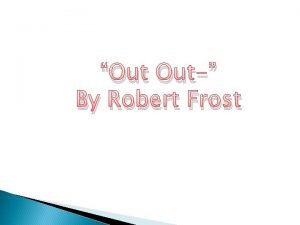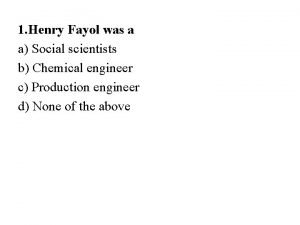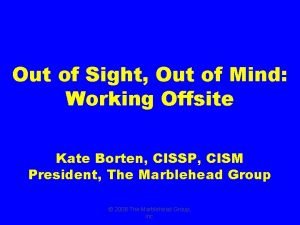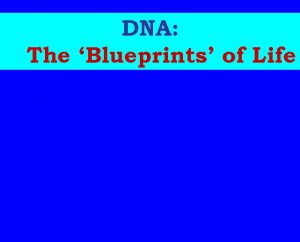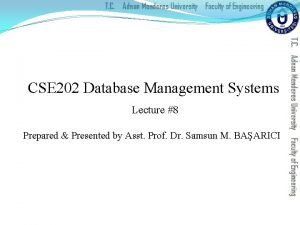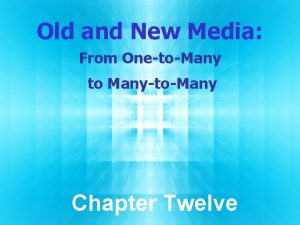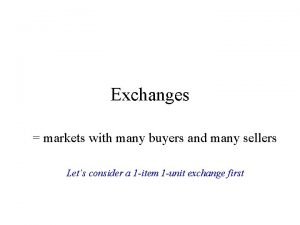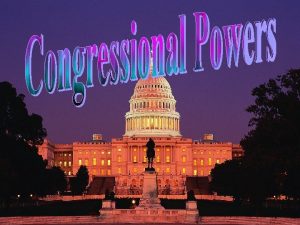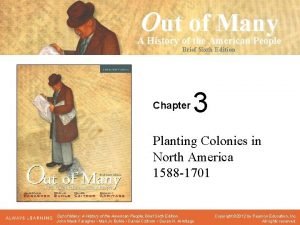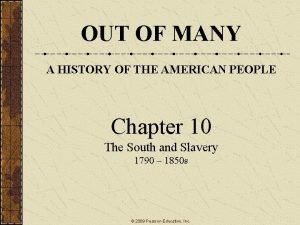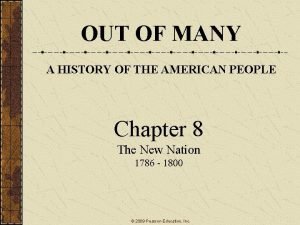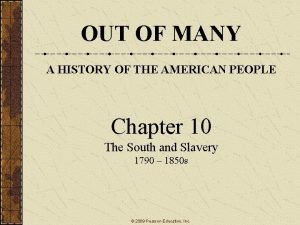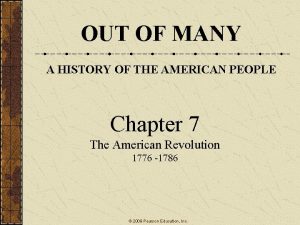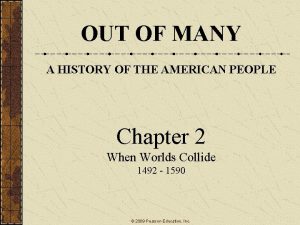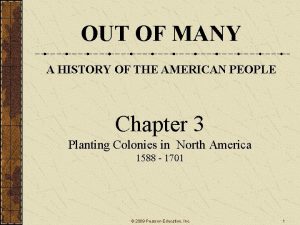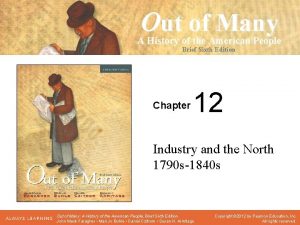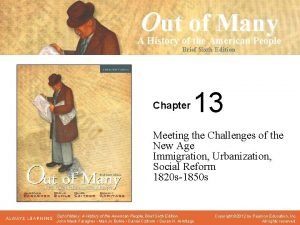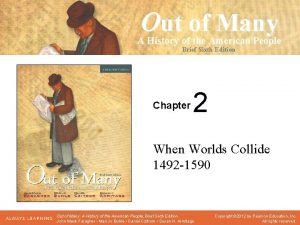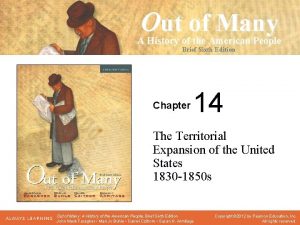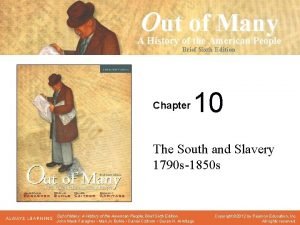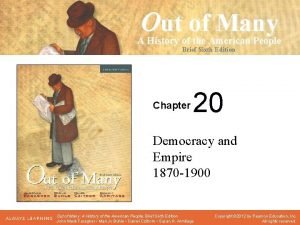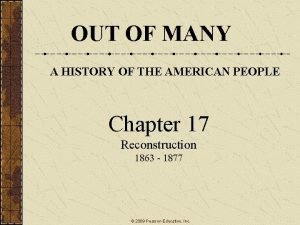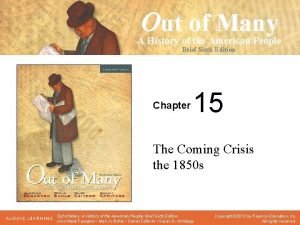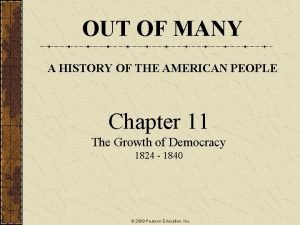OUT OF MANY A HISTORY OF THE AMERICAN





































































- Slides: 69

OUT OF MANY A HISTORY OF THE AMERICAN PEOPLE Chapter 30 The Conservative Ascendancy 1974 - 1991 © 2009 Pearson Education, Inc.

Part One: Introduction © 2009 Pearson Education, Inc. 2

Chapter Focus Questions What explains the weakness in the U. S. economy in the 1970 s? What did Ford and Carter accomplish as presidents? How successful was the environmentalist movement of the 1970 s? What are the factors behind the rise of the New Right? How did the Iran hostage crisis affect the election of 1980? What economic assumptions underlay “Reaganonics”? Why did the gap between rich and poor grow in the 1980 s? How did the Cold War end? © 2009 Pearson Education, Inc. 3

Part Two: American Communities: Grass Roots Conservatism in Orange County, California © 2009 Pearson Education, Inc. 4

American Communities: Grass Roots Conservatism in Orange County, California In 1962, Garden Grove resident Bee Gathright discovered she was a conservative. Gathright and her husband Neil soon joined the California Republican Assembly and were active in Barry Goldwater’s 1964 presidential campaign. In the 1960 s and 1970 s, Orange County had thousands of “kitchen table” activists who began transforming American conservatism and American politics, leading to the election of Ronald Reagan as president. Conservative rhetoric shed its extremist message by stressing less government and family issues. Evangelical religion also played a role. © 2009 Pearson Education, Inc. 5

Part Three: The Overextended Society © 2009 Pearson Education, Inc. 6

The Troubled Economy Map: World’s Leading Oil Producers The energy crisis was the most vivid sign of a troubled economy. Dependence on imported oil had steadily grown. President Nixon ordered oil conservation measures. Chart: Decline of U. S. Oil Consumption, 1975 -81 Soaring energy prices led to rapid, sustained inflation. Steel and auto making faced stiff competition and declining market shares. Chart: Union Membership, 1940 -90 © 2009 Pearson Education, Inc. 7

MAP 30. 1 World’s Leading Oil Producers © 2009 Pearson Education, Inc. 8

FIGURE 30. 1 Decline of U. S. Oil Consumption, 1975 -81 Boycotts causing shortages and high prices spurred the reduction in oil consumption. However, in the 1980 s consumption once again began to rise to reach record highs. Source: Department of Energy, Monthly Energy Review, June 1982. © 2009 Pearson Education, Inc. 9

FIGURE 30. 2 Union Membership, 1940 -90 After reaching a peak during World War II, union membership steadily declined. In the 1980 s, overseas production took an especially big toll on industrial unions. SOURCE: Bureau of Labor Statistics, in Mary Kupiec et al. , eds. , Encyclopedia of American Social History, Vol. II. New York: Scribner’s, 1993, p. 4188. © 2009 Pearson Education, Inc. 10

Sunbelt/Snowbelt Communities Map: Population Shifts, 1970 -80 Large-scale migration fueled Sunbelt population growth. Sunbelt prosperity was not evenly spread and a two-tier class society developed. Snowbelt cities like Philadelphia and New York faced urban decay. Chart: Growth of Sunbelt Cities, 1940 -80 © 2009 Pearson Education, Inc. 11

MAP 30. 2 Population Shifts, 1970– 80 Industrial decline in the Northeast coincided with an economic boom in the Sunbelt, encouraging millions of Americans to head for warmer climates and better jobs. © 2009 Pearson Education, Inc. 12

FIGURE 30. 3 Growth of Sunbelt Cities, 1940 -80 The old industrial cities in the Northeast and Midwest steadily lost population to the southern and western decentralized cities and their surrounding suburbs. SOURCE: U. S. Bureau of the Census. © 2009 Pearson Education, Inc. 13

The Endangered Environment The linking of cancer at Love Canal to toxic waste raised U. S. concern over pollution. Growing interest in the concept of ecology led Americans to lobby for renewable energy sources, protecting endangered species, and reducing pollution. Despite public outcries, government officials frequently responded to other pressures. © 2009 Pearson Education, Inc. 14

The media attention given to Love Canal residents, who reported high incidents of birth defects and rates of cancer, led to the passage of a new federal law in 1980 regulating toxic waste disposal. This photograph shows one of the endangered children demonstrating during a neighborhood meeting. © 2009 Pearson Education, Inc. 15

“Lean Years Presidents”: Ford and Carter Map: The Election of 1976 Gerald Ford succeeded to the presidency following Richard Nixon’s resignation. After pardoning Nixon, Ford lost the nation’s trust. Democrats turned to Georgia Governor Jimmy Carter narrowly defeated Ford, building on his moderate image, his outsider status, and his pledge to restore trust. Carter by and large supported conservative policies like deregulation and increased military spending. Inflation and interest rates soared, leading many to conclude that Carter could not turn the economy around. © 2009 Pearson Education, Inc. 16

MAP 30. 3 The Election of 1976 Incumbent Gerald Ford could not prevail over the disgrace brought to the Republican Party by Richard Nixon. The lingering pall of the Watergate scandal, especially Ford’s pardon of Nixon, worked to the advantage of Jimmy Carter, who campaigned as an outsider to national politics. Although Carter and his running mate Walter Mondale won by only a narrow margin, the Democrats gained control of both the White House and Congress. © 2009 Pearson Education, Inc. 17

The New Urban Politics Political mobilization during the 1970 s frequently focused on community issues that cut across ideological lines. College students, along with African Americans and other minorities, mobilized and won power in numerous communities. Several major cities elected black mayors. The fiscal crisis of the 1970 s frequently foiled their plans for reforms. © 2009 Pearson Education, Inc. 18

Part Four: The Limits of Global Power © 2009 Pearson Education, Inc. 19

The Limits of Global Power Presidents Ford and Carter both believed that American power had been declining and that there should be no more Vietnams. © 2009 Pearson Education, Inc. 20

Detente American diplomats sought a way to wind down the cold war by getting the Soviets to agree to respect human rights and by negotiating arms control agreements. © 2009 Pearson Education, Inc. 21

Foreign Policy and “Moral Principles” Jimmy Carter pledged to put human rights at the center of his foreign policy. His greatest success came when he negotiated the Camp David Accord between Egypt and Israel, though the agreement did not bring stability to the region. Carter reformed the CIA and returned the Canal Zone to Panama. © 2009 Pearson Education, Inc. 22

President Carter signs the Middle East Peace Treaty with Egyptian President Anwar Sadat and Israeli Prime Minister Menachem Begin, in Washington, DC, March 1979. President Carter had invited both leaders to Camp David, the presidential retreat in Maryland, where for two weeks he mediated between them on territorial rights to the West Bank and Gaza Strip. Considered Carter’s greatest achievement in foreign policy, the negotiations, known as the Camp David Peace Accords, resulted in not only the historic peace treaty but the Nobel Peace Prize for Begin and Sadat. © 2009 Pearson Education, Inc. 23

(Mis)Handling the Unexpected Carter received contradictory advice urging him to be both tough on and conciliatory toward the Soviets. His Third World efforts received mixed support for both authoritarian and revolutionary governments. He reacted strongly to a Soviet intervention in Afghanistan. © 2009 Pearson Education, Inc. 24

The Iran Hostage Crisis Carter’s decision to allow the deposed shah of Iran to enter the country for medical treatment backfired. Iranian students seized the American embassy and held its personnel hostage. He tried diplomacy and at the same time an ill-fated rescue operation. Both failed. © 2009 Pearson Education, Inc. 25

Iranians demonstrate outside the U. S. Embassy in Tehran, raising a poster with a caricature of President Carter. The Iran hostage crisis, which began November 8, 1979, when a mob of Iranians seized the U. S. embassy in Tehran, contributed to Carter’s defeat at the polls the following year. Fifty-two embassy employees were held hostage for 444 days. © 2009 Pearson Education, Inc. 26

Part Five: The New Right © 2009 Pearson Education, Inc. 27

Neoconservatism A variety of forces converged to turn back the great society and form the New Right such as conservative centers like the Heritage Foundation. © 2009 Pearson Education, Inc. 28

The Religious Right The New Right promoted its agenda through televangelists. Protestant ministers were determined to roll back liberalism. © 2009 Pearson Education, Inc. 29

Christian televangelists Jim and Tammy Bakker hosted the popular “PTL Club” and capitalized on their success to build the PTL Network and Heritage USA, ” which grew to become one of the largest and best attended theme parks in the United States. This photograph, taken in 1986, shows the couple shortly before reports of financial irregularities and a sex scandal forced Jim Bakker to resign from his PTL ministry. They divorced in 1992 following Jim Bakker’s conviction on federal charges of fraud and racketeering. © 2009 Pearson Education, Inc. 30

The Pro-Family Movement The New Right successfully blocked ratification of the ERA and rallied support for efforts to make abortions illegal. © 2009 Pearson Education, Inc. 31

The Election of 1980 Map: The Election of 1980 As the election of 1980 approached, an unenthusiastic Democratic convention endorsed him. The Republicans nominated Ronald Reagan, who asked voters, “Are you better off now than you were four years ago? ” Reagan won 50. 9 percent of the vote but an overwhelming majority in the electoral college. © 2009 Pearson Education, Inc. 32

MAP 30. 4 The Election of 1980 Ronald Reagan won a landslide victory over incumbent Jimmy Carter, who managed to carry only six states and the District of Columbia. Reagan attracted millions of traditionally Democratic voters to the Republican camp. © 2009 Pearson Education, Inc. 33

Seeing History The Presidential Inauguration of Ronald Reagan. © 2009 Pearson Education, Inc. 34

Part Six: The Reagan Revolution © 2009 Pearson Education, Inc. 35

The Great Communicator Ronald Reagan credited his political success to his earlier acting career. He interpreted the 1980 election as a popular mandate for conservatives. © 2009 Pearson Education, Inc. 36

Ronald Reagan, the fortieth president of the United States, was known for his ability to articulate broad principles of government in a clear fashion. The most popular president since Dwight Eisenhower, he built a strong coalition of supporters from long-term Republicans, disillusioned Democrats, and evangelical Protestants. © 2009 Pearson Education, Inc. 37

Reaganomics is based on a supply-side economic theory: Essentially, a successful economy depended upon the proliferation of the rich. The Economic Recovery Tax Act of 1981: the largest tax cut in the nation’s history. The Omnibus Reconciliation Act of 1981: a comprehensive program of federal spending cuts. While decreasing spending on domestic programs, Reagan greatly increased defense budget. © 2009 Pearson Education, Inc. 38

The Election of 1984 In the 1984 election, Walter Mondale won the Democratic nomination by concentrating on the traditional Democratic constituencies. Reagan countered Mondale’s criticisms by claiming that the nation was strong, united, and prosperous. Reagan won in one of history’s biggest landslides. © 2009 Pearson Education, Inc. 39

Recession, Recovery, Fiscal Crisis A recession gripped the economy during the early 1980 s. By the mid-1980 s the economy grew and inflation was under control. Enormous budget deficits grew to an unprecedented $2. 7 trillion as the U. S. became the world’s leading debtor. The fiscal crisis was made worse by scandals in the securities industry. In 1987, the stock market crashed, ending the bull market of the 1980 s. Chart: Federal Budget Deficit and National Debt, 1970 -98 © 2009 Pearson Education, Inc. 40

FIGURE 30. 4 Federal Budget Deficit and National Debt, 1970 -98 Tax cuts combined with huge increases in defense spending created a sharp increase in the budget deficit during the Republican administrations. SOURCE: Statistical abstract of the United States, in Nash et al. , The American People, 5 th ed. , p. 988. © 2009 Pearson Education, Inc. 41

After the Dow Jones reached an all-time high at the end of August, stocks began to slide and then crashed. On October 19, 1987—“Black Monday”—traders at the New York Stock Exchange panicked, selling off stocks at such a rate that the market lost almost twenty-three percent of its value, marking the end of a five-year bull market. The market soon bounced back, and by September 1989 the Dow Jones had made up all its losses. © 2009 Pearson Education, Inc. 42

Part Seven: Best of Times, Worst of Times © 2009 Pearson Education, Inc. 43

A Two-Tiered Society While the 1980 s celebrated wealth and moneymaking, the gap between rich and poor widened. During the 1980 s, the average weekly earnings declined substantially. Half the new jobs did not pay enough to keep a family out of poverty. Race sharply defined the gap between rich and poor. © 2009 Pearson Education, Inc. 44

A Two-Tiered Society Table: Percentage Share of Aggregate Family Income, 1980 -92 Table: Share of Total Net Worth of American Families Table: Measures of Average Earnings, 1980 -92 (in 1990 Dollars) Table: Number of Poor, Rate of Poverty, and Poverty Line, 1979 -92 Table: Net New Job Creation by Wage Level, 1979 -87 Table: Median Family Income and Ratio to White, by Race and Hispanic Origin, 1980 -92 (in 1992 Dollars) © 2009 Pearson Education, Inc. 45

© 2009 Pearson Education, Inc. 46

© 2009 Pearson Education, Inc. 47

© 2009 Pearson Education, Inc. 48

© 2009 Pearson Education, Inc. 49

© 2009 Pearson Education, Inc. 50

© 2009 Pearson Education, Inc. 51

The Feminization of Poverty Women experienced declining earning power during this period. Divorce contributed significantly to female poverty—new no-fault divorce laws. A sharp rise in teenage pregnancy also contributed. © 2009 Pearson Education, Inc. 52

Epidemics: Drugs, AIDS, Homelessness The 1980 s saw new epidemics erupt. Cocaine and inner-city crack use spiraled, unleashing a crime wave. The Reagan administration declared a war on drugs, but concentrated its resources on the overseas supply and did little to control demand at home. In 1981, doctors identified a puzzling disease initially found among gay men—AIDS. An epidemic of homelessness grew during the decade. One-third were mental patients discharged from psychiatric hospitals. © 2009 Pearson Education, Inc. 53

In May 1987, members of the Lesbian and Gay Community Services in downtown Manhattan organized ACT-UP. Protesting what they perceived to be the Reagan administration’s mismanagement of the AIDs crisis, they used nonviolent direct action, which often took the form of dramatic acts of civil disobedience. ACT-UP grew to more than seventy chapters in the United States and the world. © 2009 Pearson Education, Inc. 54

Part Eight: Toward A New World Order © 2009 Pearson Education, Inc. 55

The Evil Empire Reagan made anti-communism the centerpiece of his foreign policy, calling the Soviet Union an “evil empire. ” He called for a space-based “Star Wars” missile defense system that many saw as an effort to achieve a first-strike capability. Attempts at meaningful arms control stalled. © 2009 Pearson Education, Inc. 56

The Reagan Doctrine and Central America Map: The United States in Central America, 1978 -90 The Reagan Doctrine pursued anticommunist activity in Central America. Reagan intervened in Grenada, E 1 Salvador, and waged a covert war against the revolutionary government of Nicaragua. © 2009 Pearson Education, Inc. 57

MAP 30. 5 The United States in Central America, 1978– 90 U. S. intervention in Central America reached a new level of intensity with the so-called Reagan Doctrine. The bulk of U. S. aid came in the form of military support for the government of El Salvador and the Contra rebels in Nicaragua. © 2009 Pearson Education, Inc. 58

The Middle East and the Iran-Contra Scandal Map: The United States in the Middle East in the 1980 s The volatility of the Middle East influenced U. S. foreign policy. In 1986, news broke of how the United States traded arms to Iran in return for their assistance in freeing hostages held by terrorist groups. The money from the arms sales was used to fund the Contras in Nicaragua. Oliver North, who ran the enterprise, acknowledged that he had told a web of lies and destroyed evidence, all in the name of patriotism. An investigating commission concluded that Reagan had allowed a small, unsupervised group to run the operation. In 1992, outgoing President George Bush, whose involvement had been the target of much speculation, pardoned several officials who were scheduled to be tried. © 2009 Pearson Education, Inc. 59

MAP 30. 6 The United States in the Middle East in the 1980 s The volatile combination of ancient religious and ethnic rivalries, oil, and emerging Islamic fundamentalism made peace and stability elusive in the Middle East. © 2009 Pearson Education, Inc. 60

Lt. Col. Oliver North, who once described the scheme to sell arms to Iran to help the Contras as a “neat idea, ” is shown testifying in July 1987 before a joint Congressional committee formed to investigate the Iran. Contra affair. © 2009 Pearson Education, Inc. 61

The Collapse of Communism In 1985, Mikhail Gorbachev came to power in the Soviet Union and instituted a series of political and economic reforms. The Soviet Union dissolved in 1991. This ended the great superpower rivalry. © 2009 Pearson Education, Inc. 62

In August 1961, the border between East and West Berlin was closed, and the Berlin Wall was built to divide the city into two sections. After twenty-eight years, on November 9, 1989, the government in East Germany lifted travel restrictions. This photograph shows demonstrators defiantly tearing down the Berlin Wall, which for three decades had embodied the political divisions of the cold war. © 2009 Pearson Education, Inc. 63

Part Nine: “A Kinder, Gentler Nation” © 2009 Pearson Education, Inc. 64

Reagan’s Successor: George H. W. Bush carried over several policies from Reagan’s administration. Bush described himself as a “compassionate” Republican. © 2009 Pearson Education, Inc. 65

The Persian Gulf War As the old geopolitical order disappeared, ideological rivalry shifted to the Middle East. Iraq seized oil fields in Kuwait and the U. S. responded swiftly. U. S. air strikes lasted 42 days, the ground war 100 hours and victory was swift. The war, however, intensified Muslim hatred of the United States. © 2009 Pearson Education, Inc. 66

The Economy and the Election of 1992 The Persian Gulf War swelled Bush’s popularity, however the economy soon pushed to drop his performance rating to just 51 percent. He faced a formidable opponent in Bill Clinton adopted many conservative themes and took 43 percent of the popular vote and carried 32 states. © 2009 Pearson Education, Inc. 67

Part Ten: Conclusion © 2009 Pearson Education, Inc. 68

© 2009 Pearson Education, Inc. 69
 Mounds
Mounds Personification in one thing by one direction
Personification in one thing by one direction Put out the light, and then put out the light
Put out the light, and then put out the light Robert frost poems
Robert frost poems Out of sight out of mind quotes
Out of sight out of mind quotes Robert frost out out
Robert frost out out Lock out tag out safety talk
Lock out tag out safety talk Robert frost out out
Robert frost out out Time
Time Matt 11 28-30 msg
Matt 11 28-30 msg Loto
Loto Out, damned spot! out, i say!
Out, damned spot! out, i say! Find out the odd one out
Find out the odd one out Makna out of sight out of mind
Makna out of sight out of mind Bgsu quality systems
Bgsu quality systems Hát kết hợp bộ gõ cơ thể
Hát kết hợp bộ gõ cơ thể Lp html
Lp html Bổ thể
Bổ thể Tỉ lệ cơ thể trẻ em
Tỉ lệ cơ thể trẻ em Gấu đi như thế nào
Gấu đi như thế nào Thang điểm glasgow
Thang điểm glasgow Hát lên người ơi
Hát lên người ơi Các môn thể thao bắt đầu bằng tiếng đua
Các môn thể thao bắt đầu bằng tiếng đua Thế nào là hệ số cao nhất
Thế nào là hệ số cao nhất Các châu lục và đại dương trên thế giới
Các châu lục và đại dương trên thế giới Công của trọng lực
Công của trọng lực Trời xanh đây là của chúng ta thể thơ
Trời xanh đây là của chúng ta thể thơ Mật thư anh em như thể tay chân
Mật thư anh em như thể tay chân Phép trừ bù
Phép trừ bù độ dài liên kết
độ dài liên kết Các châu lục và đại dương trên thế giới
Các châu lục và đại dương trên thế giới Thơ thất ngôn tứ tuyệt đường luật
Thơ thất ngôn tứ tuyệt đường luật Quá trình desamine hóa có thể tạo ra
Quá trình desamine hóa có thể tạo ra Một số thể thơ truyền thống
Một số thể thơ truyền thống Bàn tay mà dây bẩn
Bàn tay mà dây bẩn Vẽ hình chiếu vuông góc của vật thể sau
Vẽ hình chiếu vuông góc của vật thể sau Thế nào là sự mỏi cơ
Thế nào là sự mỏi cơ đặc điểm cơ thể của người tối cổ
đặc điểm cơ thể của người tối cổ Thế nào là giọng cùng tên
Thế nào là giọng cùng tên Vẽ hình chiếu đứng bằng cạnh của vật thể
Vẽ hình chiếu đứng bằng cạnh của vật thể Tia chieu sa te
Tia chieu sa te Thẻ vin
Thẻ vin đại từ thay thế
đại từ thay thế điện thế nghỉ
điện thế nghỉ Tư thế ngồi viết
Tư thế ngồi viết Diễn thế sinh thái là
Diễn thế sinh thái là Các loại đột biến cấu trúc nhiễm sắc thể
Các loại đột biến cấu trúc nhiễm sắc thể Số nguyên là gì
Số nguyên là gì Tư thế ngồi viết
Tư thế ngồi viết Lời thề hippocrates
Lời thề hippocrates Thiếu nhi thế giới liên hoan
Thiếu nhi thế giới liên hoan ưu thế lai là gì
ưu thế lai là gì Sự nuôi và dạy con của hươu
Sự nuôi và dạy con của hươu Sự nuôi và dạy con của hươu
Sự nuôi và dạy con của hươu Sơ đồ cơ thể người
Sơ đồ cơ thể người Từ ngữ thể hiện lòng nhân hậu
Từ ngữ thể hiện lòng nhân hậu Thế nào là mạng điện lắp đặt kiểu nổi
Thế nào là mạng điện lắp đặt kiểu nổi One out of many naipaul
One out of many naipaul How many words can you make out of deoxyribonucleic acid
How many words can you make out of deoxyribonucleic acid Perfect competition 4 conditions
Perfect competition 4 conditions Er diagram
Er diagram Unary many to many
Unary many to many Erd vs erm
Erd vs erm Unary many to many
Unary many to many Contoh erd one to many
Contoh erd one to many Unary many to many
Unary many to many Many to many communication
Many to many communication Sqlbi many to many
Sqlbi many to many Example of unary relationship
Example of unary relationship Many sellers and many buyers
Many sellers and many buyers
